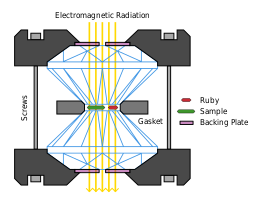
A diamond anvil cell (DAC) is a high-pressure device used in geology, engineering, and materials science experiments. It permits the compression of a small (sub-millimeter-sized) piece of material to extreme pressures, typically up to around 100–200 gigapascals, although it is possible to achieve pressures up to 770 gigapascals (7,700,000 bars or 7.7 million atmospheres).[1][2]
The device has been used to recreate the pressure existing deep inside planets to synthesize materials and phases not observed under normal ambient conditions. Notable examples include the non-molecular ice X,[3] polymeric nitrogen[4] and metallic phases of xenon,[5] lonsdaleite, and potentially metallic hydrogen.[6]
A DAC consists of two opposing diamonds with a sample compressed between the polished culets (tips). Pressure may be monitored using a reference material whose behavior under pressure is known. Common pressure standards include ruby fluorescence,[7] and various structurally simple metals, such as copper or platinum.[8] The uniaxial pressure supplied by the DAC may be transformed into uniform hydrostatic pressure using a pressure-transmitting medium, such as argon, xenon, hydrogen, helium, paraffin oil or a mixture of methanol and ethanol.[9] The pressure-transmitting medium is enclosed by a gasket and the two diamond anvils. The sample can be viewed through the diamonds and illuminated by X-rays and visible light. In this way, X-ray diffraction and fluorescence; optical absorption and photoluminescence; Mössbauer, Raman and Brillouin scattering; positron annihilation and other signals can be measured from materials under high pressure. Magnetic and microwave fields can be applied externally to the cell allowing nuclear magnetic resonance, electron paramagnetic resonance and other magnetic measurements.[10] Attaching electrodes to the sample allows electrical and magnetoelectrical measurements as well as heating up the sample to a few thousand degrees. Much higher temperatures (up to 7000 K)[11] can be achieved with laser-induced heating,[12] and cooling down to millikelvins has been demonstrated.[9]
- ^ "Improved diamond anvil cell allows higher pressures". Physics World. 2 November 2012.
- ^ "Record high pressure squeezes secrets out of osmium: X-ray experiments reveal peculiar behaviour of the most incompressible metal on Earth". ScienceDaily. Retrieved 2018-10-10.
- ^ Goncharov, A.F.; Struzhkin, V.V.; Somayazulu, M.S.; Hemley, R.J.; Mao, H.K. (July 1986). "Compression of ice to 210 gigapascals: Infrared evidence for a symmetric hydrogen-bonded phase". Science. 273 (5272): 218–230. Bibcode:1996Sci...273..218G. doi:10.1126/science.273.5272.218. PMID 8662500. S2CID 10364693.
- ^ Eremets, M.I.; Hemley, R.J.; Mao, H.K.; Gregoryanz, E. (May 2001). "Semiconducting non-molecular nitrogen up to 240 GPa and its low-pressure stability". Nature. 411 (6834): 170–174. Bibcode:2001Natur.411..170E. doi:10.1038/35075531. PMID 11346788. S2CID 4359193.
- ^ Caldwell, W.A.; Nguyen, J.; Pfrommer, B.; Louie, S.; Jeanloz, R. (1997). "Structure, bonding and geochemistry of xenon at high pressures". Science. 277 (5328): 930–933. doi:10.1126/science.277.5328.930.
- ^ Castelvecchi, D. (2017). "Physicists doubt bold report of metallic hydrogen". Nature. 542 (7639): 17. Bibcode:2017Natur.542...17C. doi:10.1038/nature.2017.21379. PMID 28150796.
- ^ Forman, Richard A.; Piermarini, Gasper J.; Barnett, J. Dean; Block, Stanley (1972). "Pressure measurement made by the utilization of ruby sharp-line luminescence". Science. 176 (4032): 284–285. Bibcode:1972Sci...176..284F. doi:10.1126/science.176.4032.284. PMID 17791916. S2CID 8845394.
- ^ Kinslow, Ray; Cable, A.J. (1970). High-velocity impact phenomena. Boston: Academic Press. ISBN 978-0-12-408950-1.
- ^ a b Jayaraman, A. (1986). "Ultrahigh pressures". Review of Scientific Instruments. 57 (6): 1013–1031. Bibcode:1986RScI...57.1013J. doi:10.1063/1.1138654.
- ^ Bromberg, Steven E.; Chan, I.Y. (1992). "Enhanced sensitivity for high-pressure EPR using dielectric resonators". Review of Scientific Instruments. 63 (7): 3670. Bibcode:1992RScI...63.3670B. doi:10.1063/1.1143596.
- ^ Chandra Shekar, N.V.; et al. (2003). "Laser-heated diamond-anvil cell (LHDAC) in materials science research". Journal of Materials Sciences and Technology. 19 (6): 518.
- ^ Subramanian, N.; et al. (2006). "Development of laser-heated diamond anvil cell facility for synthesis of novel materials" (PDF). Current Science. 91: 175.